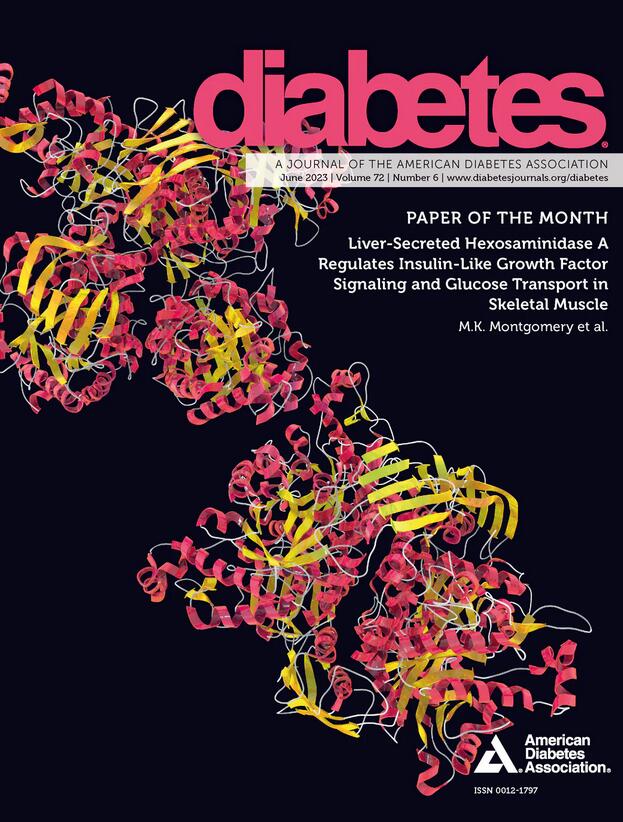Proinflammatory Stress Activates Neutral Sphingomyelinase 2–Based Generation of a Ceramide-Enriched β-Cell EV Subpopulation
IF 7.5
1区 医学
Q1 ENDOCRINOLOGY & METABOLISM
引用次数: 0
Abstract
β-cell extracellular vesicles (EVs) play a role as paracrine effectors in islet health, yet mechanisms connecting β-cell stress to changes in EV cargo and potential impacts on diabetes remain poorly defined. We hypothesized that β-cell inflammatory stress engages neutral sphingomyelinase 2 (nSMase2)–dependent EV formation pathways, generating ceramide-enriched small EVs that could impact surrounding β-cells. Consistent with this, proinflammatory cytokine treatment of INS-1 β-cells and human islets concurrently increased β-cell nSMase2 and ceramide abundance, as well as small EV ceramide species. Direct chemical activation or genetic knockdown of nSMase2, chemical treatment to inhibit cell death pathways, or treatment with a glucagon-like peptide-1 (GLP-1) receptor agonist also modulated β-cell EV ceramide. RNA sequencing of ceramide-enriched EVs identified a distinct set of miRNAs linked to β-cell function and identity. EV treatment from cytokine-exposed parent cells inhibited peak glucose-stimulated insulin secretion in wild-type recipient cells; this effect was abrogated when using EVs from nSMase2 knockdown parent cells. Finally, plasma EVs in children with recent-onset type 1 diabetes showed increases in multiple ceramide species. These findings highlight nSMase2 as a regulator of β-cell EV cargo and identify ceramide-enriched EV populations as a contributor to EV-related paracrine signaling under conditions of β-cell inflammatory stress and death. ARTICLE HIGHLIGHTS Mechanisms connecting β-cell stress to extracellular vesicle (EV) cargo and diabetes are poorly defined. Does β-cell inflammatory stress engage neutral sphingomyelinase 2 (nSMase2)–dependent EV formation to generate ceramide-enriched small EVs? Proinflammatory cytokines increased β-cell small EV ceramide via increases in nSMase2. Ceramide-enriched EVs housed distinct cargo linked to insulin signaling, and ceramide species were enriched in plasma EVs from individuals with type 1 diabetes. Ceramide-enriched EV populations are a potential contributor to β-cell EV-related paracrine signaling.促炎应激激活中性鞘磷脂酶2 -基神经酰胺富集β-细胞EV亚群的生成
β细胞胞外囊泡(EVs)在胰岛健康中扮演着旁分泌效应物的角色,然而,将β细胞应激与EVs载重变化和对糖尿病的潜在影响联系起来的机制仍不清楚。我们假设β细胞炎症应激参与中性鞘磷脂酶2 (nSMase2)依赖的EV形成途径,产生富含神经酰胺的小EV,可以影响周围的β细胞。与此一致的是,促炎细胞因子处理INS-1 β-细胞和人胰岛同时增加β-细胞nSMase2和神经酰胺丰度,以及小EV神经酰胺种类。直接化学激活或基因敲低nSMase2,化学处理以抑制细胞死亡途径,或胰高血糖素样肽-1 (GLP-1)受体激动剂处理也可调节β-细胞EV神经酰胺。神经酰胺富集ev的RNA测序鉴定出一组与β细胞功能和身份相关的独特mirna。暴露于细胞因子的亲本细胞的EV处理抑制了野生型受体细胞葡萄糖刺激的胰岛素分泌峰值;当使用来自nSMase2敲低亲本细胞的ev时,这种效应被消除。最后,最近发病的1型糖尿病儿童血浆EVs显示多种神经酰胺种类的增加。这些发现强调了nSMase2作为β细胞EV货物的调节剂,并确定了在β细胞炎症应激和死亡条件下,神经酰胺富集的EV群体作为EV相关旁分泌信号的一个因素。连接β细胞应激与细胞外囊泡(EV)货物和糖尿病的机制尚不明确。β细胞炎症应激是否参与中性鞘磷脂酶2 (nSMase2)依赖性EV的形成以产生富含神经酰胺的小型EV ?促炎细胞因子通过增加nSMase2增加β细胞小EV神经酰胺。神经酰胺富集的ev含有与胰岛素信号相关的独特货物,神经酰胺种类在1型糖尿病患者的血浆ev中富集。神经酰胺富集的EV群体是β细胞EV相关旁分泌信号的潜在贡献者。
本文章由计算机程序翻译,如有差异,请以英文原文为准。
求助全文
约1分钟内获得全文
求助全文
来源期刊

Diabetes
医学-内分泌学与代谢
CiteScore
12.50
自引率
2.60%
发文量
1968
审稿时长
1 months
期刊介绍:
Diabetes is a scientific journal that publishes original research exploring the physiological and pathophysiological aspects of diabetes mellitus. We encourage submissions of manuscripts pertaining to laboratory, animal, or human research, covering a wide range of topics. Our primary focus is on investigative reports investigating various aspects such as the development and progression of diabetes, along with its associated complications. We also welcome studies delving into normal and pathological pancreatic islet function and intermediary metabolism, as well as exploring the mechanisms of drug and hormone action from a pharmacological perspective. Additionally, we encourage submissions that delve into the biochemical and molecular aspects of both normal and abnormal biological processes.
However, it is important to note that we do not publish studies relating to diabetes education or the application of accepted therapeutic and diagnostic approaches to patients with diabetes mellitus. Our aim is to provide a platform for research that contributes to advancing our understanding of the underlying mechanisms and processes of diabetes.
 求助内容:
求助内容: 应助结果提醒方式:
应助结果提醒方式:


